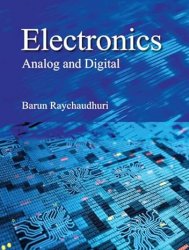Electronics : Analog and Digital
- Добавил: literator
- Дата: 1-01-2024, 05:12
- Комментариев: 0
 Название: Electronics: Analog and Digital
Название: Electronics: Analog and DigitalАвтор: Barun Raychaudhuri
Издательство: Cambridge University Press
Год: 2022
Страниц: 708
Язык: английский
Формат: pdf (true)
Размер: 76.9 MB
Analog and digital electronics are an important part of most modern courses in physics. Closely mapped to the current UGC CBCS syllabus, this comprehensive textbook will be a vital resource for undergraduate students of physics and electronics. The content is structured to emphasize fundamental concepts and applications of various circuits and instruments. A wide range of topics like semiconductor physics, diodes, transistors, amplifiers, Boolean algebra, combinational and sequential logic circuits, and microprocessors are covered in lucid language and illustrated with many diagrams and examples for easy understanding. A diverse set of questions in each chapter, including multiple-choice, reasoning, numerical, and practice problems, will help students consolidate the knowledge gained. Finally, computer simulations and project ideas for projects will help readers apply the theoretical concepts and encourage experiential learning.
The topics of electronic devices, circuits and systems are broadly classified into two categories: analog and digital, as is also specified in the CBCS curriculum. Maintaining the recommended topics, the subject matters are reorganized so as to facilitate the students. The first introductory chapter outlines briefly the evolution, significance and widespread applications of electronics. Since semiconductors take major part in the fabrication of electronic devices, the subject learning starts with the basic properties and types of semiconductors, electrons and holes, concepts of energy band and effective mass and current transport phenomena (Chapter 2).
A fundamental structure in electronics is p–n junction. Chapter 3 explains its rectification property, forward and reverse biasing and the corresponding energy band diagrams. It also elucidates how the same p–n junction with constructional changes can give rise to different devices, such as rectifier diode, Zener diode and light-emitting diode. The important applications of diode as half-wave, full-wave and bridge rectifier, clipper and clamper are presented in Chapter 4.
The bipolar junction transistor (BJT) is a very remarkable device in electronics. It is the basic building block for many analog and digital circuits. So the book dedicates four chapters on different aspects of transistor. Chapter 5 contains the construction and working principle of n–p–n and p–n–p transistors, the amplifying action of transistor and detailed explanations of common-emitter, common-base and common-collector configurations.
...
Chapter 12 contains some discrete but important subjects of technology and instrumentation, namely integrated circuit (IC) and cathode ray oscilloscope (CRO). The devices and circuits in the previous chapters are analog in nature. The remaining chapters deal with digital systems.
Chapter 13 introduces digital electronics, different number systems and their interconversions, Boolean algebra and basic logic operations. Chapter 14 comprises the combinational logic circuits. It interprets the logic gates, such as AND, OR, NOT, universal gates, namely NAND and NOR and arithmetic and data processing circuits made of these, such as adder, subtractor, multiplexer and demultiplexer. Chapter 15 includes the sequential logic circuits, namely flip-flops, registers, counters and memories. Chapter 16 introduces the techniques of converting analog to digital and vice versa. Also different types of memory elements are outlined. Chapter 17 presents a brief sketch of the basic principles and architecture of a modern computer and explains in detail the programming technique for Microprocessor 8085. A brief idea is given on Arduino microcontroller system.
Скачать Electronics : Analog and Digital
[related-news] [/related-news]
Внимание
Уважаемый посетитель, Вы зашли на сайт как незарегистрированный пользователь.
Мы рекомендуем Вам зарегистрироваться либо войти на сайт под своим именем.
Уважаемый посетитель, Вы зашли на сайт как незарегистрированный пользователь.
Мы рекомендуем Вам зарегистрироваться либо войти на сайт под своим именем.
